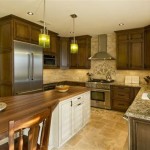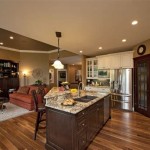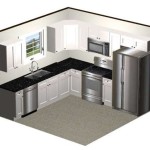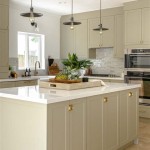Where Should Knobs Be Placed On Kitchen Cabinets: A Comprehensive Guide
The placement of knobs on kitchen cabinets may seem like a minor detail, but it significantly impacts the overall aesthetic and functionality of the kitchen. Thoughtful placement contributes to a cohesive design, enhances ease of use, and reflects attention to detail. Neglecting this aspect can result in an unbalanced look, awkward ergonomics, and a less-than-satisfactory kitchen experience. This article offers a detailed guide to determine the optimal positioning of knobs on various types of kitchen cabinets.
Before delving into specifics, it is crucial to consider the overall design style of the kitchen. Traditional kitchens often benefit from symmetrical and classic knob placements, while contemporary designs may allow for more creative and asymmetrical approaches. The hardware finish also plays a role; for example, brushed nickel or stainless steel knobs may complement a modern aesthetic, while antique brass or bronze knobs may suit a more traditional setting. Regardless of style, consistency in placement – whether adhering to strict measurements or creating a visually balanced effect – is essential throughout the kitchen.
Furthermore, the size and shape of the knobs themselves must be considered. Larger knobs might require a slightly different placement than smaller, more discreet knobs to maintain visual harmony. The material of the cabinet doors and drawers also influences the ease of installation and the durability of the chosen placement. Solid wood cabinets offer greater flexibility than laminate or veneer cabinets, which may be more susceptible to damage if knobs are installed too close to the edge.
Determining Knob Placement on Upper Cabinets
Upper cabinets, typically used for storing dishes, glassware, and other frequently used items, necessitate careful knob placement for optimal accessibility. Several factors influence the ideal positioning, including the cabinet door style (overlay or inset), the cabinet height, and the user's reach. A general guideline is to position knobs vertically approximately 2 1/2 to 3 inches from the bottom corner of the cabinet door. This placement allows for a comfortable grip and minimizes strain on the wrist when opening and closing the cabinet.
For upper cabinets with a recessed panel, the knob can be centered on the panel itself for a more decorative effect. However, this placement should be carefully considered to ensure it does not compromise functionality. The knob should still be within easy reach and provide sufficient leverage for opening the door without difficulty. If the panel is very small, adhering to the 2 1/2 to 3 inch guideline may be more practical.
If the upper cabinets extend to the ceiling, or are significantly taller than standard height, consider adjusting the knob placement accordingly. A slightly higher placement might be necessary to maintain comfortable reach for taller individuals. It's beneficial to physically mock up the knob placement before drilling any holes, using painter's tape to temporarily affix knobs in different positions and test the ergonomics.
When dealing with pairs of upper cabinets flanking a range hood or window, strive for symmetrical knob placement. This creates a balanced and visually appealing look. Measure carefully and double-check the alignment before drilling. The use of a laser level can be helpful in ensuring that the knobs are perfectly aligned horizontally.
For cabinets above appliances such as refrigerators or microwaves, the knob placement may need to be adjusted to account for the appliance clearance. In these situations, prioritize functionality and accessibility, even if it means deviating slightly from the standard placement guidelines.
Optimal Knob Placement on Lower Cabinets and Drawers
Lower cabinets and drawers demand a different approach to knob placement due to their location and function. Lower cabinets often house heavier items, such as pots, pans, and small appliances, requiring a more secure grip. Drawers, particularly those storing utensils or cookware, require easy access and smooth operation.
For lower cabinet doors, the standard recommendation is to position knobs approximately 2 1/2 to 3 inches from the top corner of the door. This is the inverse of the upper cabinet placement, maintaining visual consistency throughout the kitchen. This placement provides adequate leverage for opening the cabinet door and keeps the knob out of the way when accessing items inside.
When it comes to drawers, the approach to knob placement depends on the size and style of the drawer. For smaller drawers, such as those typically found in a cutlery organizer, a single knob centered horizontally and vertically on the drawer front is often the most appropriate choice. This placement provides a balanced and symmetrical look.
For wider drawers, consider using two knobs. In this case, the knobs should be placed equidistantly from the center of the drawer, typically about one-third of the drawer width from each edge. This provides a more balanced pull and reduces strain on the drawer glides, particularly when the drawer is heavily loaded. An alternative approach is to use pulls instead of knobs for wider drawers, as pulls offer a more ergonomic grip and distribute the pulling force more evenly.
On larger, deeper drawers used for pots and pans or other heavy items it makes sense to consider pulls instead of knobs. The additional leverage provided by pulls can make opening these drawers considerably easier and more ergonomic. However, if knobs are preferred for aesthetic reasons, ensure that they are robust and securely attached to the drawer front.
Pay particular attention to the placement of knobs on drawers located near corners. Ensure that the knob does not interfere with the adjacent cabinet or appliance when the drawer is opened. Adjust the placement slightly if necessary to allow for smooth and unobstructed operation.
Practical Considerations and Installation Tips
Beyond the general guidelines outlined above, several practical considerations can further refine knob placement decisions. The type of cabinet construction, the presence of decorative molding, and personal preferences can all influence the final placement. It's also essential to consider the tools and techniques used for installation to ensure a clean and durable result.
Before drilling any holes, create a template to ensure consistent knob placement throughout the kitchen. This can be a simple piece of cardboard or a more sophisticated commercially available template. The template should accurately mark the location of the screw holes, allowing for precise and repeatable placement.
Use a drill bit that is slightly smaller than the screw size to create a pilot hole. This prevents the wood from splitting and makes it easier to drive the screw straight. When drilling through laminate or veneer cabinets, use a brad point drill bit to minimize chipping.
When attaching the knobs, avoid over-tightening the screws. This can damage the cabinet door or drawer front and may eventually cause the knob to loosen. Tighten the screws just enough to secure the knob firmly in place.
Regularly check the tightness of the knobs, especially on frequently used cabinets and drawers. Loose knobs can be easily overtightened, causing damage to the cabinet but also presenting a safety hazard. Use a screwdriver to tighten them as needed.
Consider the overall workflow in the kitchen when determining knob placement. Position knobs in a way that minimizes unnecessary movement and maximizes efficiency. For example, knobs on cabinets near the stovetop or sink should be easily accessible while cooking or cleaning.
Ultimately, the best knob placement is one that balances aesthetics with functionality and personal preference. Use the guidelines outlined in this article as a starting point, but don't be afraid to experiment and adjust the placement to suit your specific needs and style. Careful planning and attention to detail will result in a kitchen that is both beautiful and functional.

A Simple Guide For Cabinet Knob Placement Julie Blanner

How To Place Cabinet Knobs Pulls

Learn How To Place Kitchen Cabinet Knobs And Pulls Cliqstudios

How To Place Cabinet Knobs Pulls

How To Choose Between Knobs Or Pulls On Kitchen Cabinets

How To Place Cabinet Knobs Pulls

A Simple Guide For Cabinet Knob Placement Julie Blanner

Learn How To Place Kitchen Cabinet Knobs And Pulls Cliqstudios

Cabinet Hardware Placement Guide

Design 101 Cabinet Hardware Placement Lark Linen








